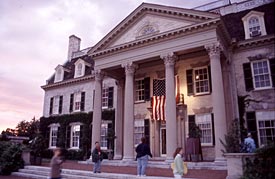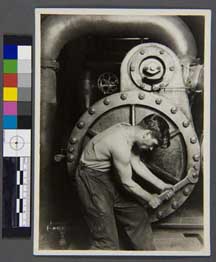 One of the most intriguing booths at the AIPAD Photography Show in New York last weekend didn’t offer anything for sale: For the first time, the George Eastman House (right) was at the fair, here from Rochester to tell people about a new joint-venture with the Rochester Institute of Technology called “The Center for the Legacy of Photography.”
One of the most intriguing booths at the AIPAD Photography Show in New York last weekend didn’t offer anything for sale: For the first time, the George Eastman House (right) was at the fair, here from Rochester to tell people about a new joint-venture with the Rochester Institute of Technology called “The Center for the Legacy of Photography.”
The Eastman House booth offered an
 exhibit called “Cause & Effect,” a series of vintage photographic prints from its collection that provided insight into “historic cause-and-effect relationships of materials and processes.” For example, there was an early salt print by the partners, David Octavius Hill and Robert Adamson, that was shown adjacent to later prints in platinum and carbon. And there were several prints of Lewis W. Hine’s Powerhouse Mechanic (left), again showing how the choice of material and process changed the aesthetics of the image.
exhibit called “Cause & Effect,” a series of vintage photographic prints from its collection that provided insight into “historic cause-and-effect relationships of materials and processes.” For example, there was an early salt print by the partners, David Octavius Hill and Robert Adamson, that was shown adjacent to later prints in platinum and carbon. And there were several prints of Lewis W. Hine’s Powerhouse Mechanic (left), again showing how the choice of material and process changed the aesthetics of the image.
The exhibition provided a window on the Center’s mission…
which is, as digital photography takes over, to focus on:
collecting and sharing knowledge about photographic materials to deepen the understanding of the photograph. The work of the Center [is] developing reference resources and learning tools and refining the inquiry to deepen the understanding of the photograph through materials-based knowledge.
The Eastman’s director, Tony Bannon (Dr. Anthony, more formally), described the Center’s rationale in an email to me:
As silver halide photography passes into history, with it will pass its industrial technology, its aesthetic and commercial context, and nearly all firsthand knowledge of its chemistry, materials, and processes. We must understand and define the ways in which the material nature of silver-based photographs differs from that of digital images and to make clear that the preservation and interpretation of the two pose distinctly different challenges, originating in different material and cultural contexts.
You can get a better understanding by looking at the beta website of one of the Center’s projects: Graphics Atlas, which allows visitors to compare an image’s trait across several processes, among other things. Another project, Notes on Photography, is a collaborative website that uses wiki technology to let collectors, curators, conservators and the general public share knowledge about photographic prints — the camera, the process, the inscriptions, the age, and so on. It is expected to debut in June.
This is cool, if sometimes esoteric, stuff — but both professionals and the public stand to gain. Here’s a link to the Center’s website.
It’s my personal pleasure to mention all this, not only because I love old photographs (and new ones, too), but also because I’m from Rochester and always happy to call attention to the treasure that the George Eastman House is.
Not to mention George Eastman himself — he was ahead of everyone on so many things, and aside from his contributions to photography, gave Rochester the Eastman Theatre, the Rochester Philharmonic Orchestra and Durand-Eastman Park, a gorgeous place. Rochester, the late University of Rochester President Rush Rhees once said, would be “difficult to imagine” without him.
Photos: Courtesy of the George Eastman House
